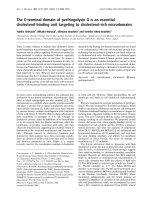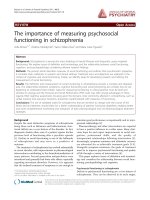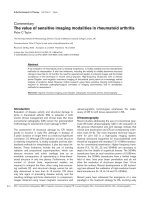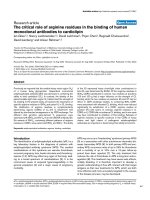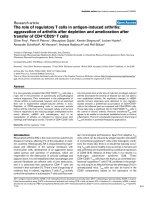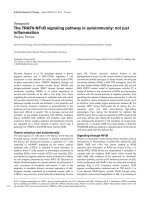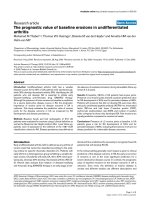Báo cáo y học: "The International Sepsis Forum’s frontiers in sepsis: high cardiac output should not be maintained in severe sepsis" pptx
Bạn đang xem bản rút gọn của tài liệu. Xem và tải ngay bản đầy đủ của tài liệu tại đây (51.85 KB, 4 trang )
272
CI = cardiac index; CO = cardiac output; DO
2
= oxygen delivery; MAP = mean arterial pressure; VO
2
= oxygen consumption.
Critical Care August 2003 Vol 7 No 4 Sharma and Dellinger
Introduction
Septic shock is a syndrome characterized by abnormal
oxygen utilization. It has been suggested that maintaining
cardiac output (CO) above normal in patients with septic
shock should increase oxygen delivery (D
O
2
) and oxygen
consumption (V
O
2
), decrease any oxygen debt present, and
potentially improve survival. However, the tissue extraction of
needed oxygen is maintained even at very low levels of D
O
2
.
Furthermore, V
O
2
increases with increasing DO
2
only up to a
point. Thereafter, subsequent increases in D
O
2
do not result
in any further increase in V
O
2
(Fig. 1). Attempts to increase
the D
O
2
beyond this point are more likely to be harmful
because the methods used (e.g. inotropes) have potential
harmful effects (such as increased oxygen demand in tissues,
tachyarrhythmias, worsening distribution of blood flow in
tissues, and myocardial ischemia).
What is the rationale for maintaining high
cardiac output?
The rationale for maintaining high CO comes from studies
that found higher levels of cardiac index (CI), D
O
2
, and VO
2
in
patients with septic shock who survived than in those who
died [1,2]. However, other studies failed to find a statistically
significant difference in these parameters between survivors
and nonsurvivors from septic shock [3–5], and one study
found V
O
2
to be significantly higher in patients with
confirmed or suspected sepsis who died, as compared with
those who survived [6]. Even assuming that survivors do have
higher levels of CI, D
O
2
, and VO
2
than do nonsurvivors, the
question is whether the higher levels of CI, D
O
2
, and VO
2
actually improve survival or are just markers for patients who
are more likely to survive.
Does oxygen consumption increase with
increasing oxygen delivery?
In the initial studies showing that an increase in DO
2
is
associated with an increase in V
O
2
(suggesting that a tissue
oxygen debt exists), both D
O
2
and VO
2
were calculated using
the Fick principle for CO [7–9]. However, if a measured
variable is used to determine two parameters, errors in
measurement may ‘couple’ the calculations (i.e. although there
may appear to be a relationship between the variables, one
may not exist at all) [10]. Hemoglobin, CO, arterial oxygen
saturation, and arterial oxygen tension are the shared variables
used in calculating both D
O
2
and VO
2
. To avoid mathematical
coupling, it has been suggested that V
O
2
be calculated by a
Commentary
The International Sepsis Forum’s frontiers in sepsis: high cardiac
output should not be maintained in severe sepsis
Vinay K Sharma
1
and R Phillip Dellinger
2
1
Attending Physician, Pulmonary and Critical Care Division, Graduate Hospital, Philadelphia, Pennsylvania, USA
2
Chief, Critical Care Section, Cooper Health System, Camden, New Jersey, USA
Correspondence: Vinay Sharma,
Published online: 3 July 2003 Critical Care 2003, 7:272-275 (DOI 10.1186/cc2350)
This article is online at />© 2003 BioMed Central Ltd (Print ISSN 1364-8535; Online ISSN 1466-609X)
Abstract
Abnormal oxygen utilisation is one of the features of septic shock. Some studies have observed that
patients that survive septic shock tend to have higher cardiac output and oxygen delivery compared to
those that do not. It has been proposed that higher than normal (or "supra-normal") levels of cardiac
output and oxygen deliver should be the goal in the management of septic shock. However,
randomised controlled trials have not been able to validate that such a goal provides a mortality or
morbidity advantage. In this commentary we discuss the various reasons put forward by the
proponents of this strategy and review the available evidence.
Keywords cardiac output, oxygen consumption, oxygen delivery, septic shock
273
Available online />different method from that used for DO
2
. Four subsequent
studies in septic patients using independent methods to
calculate the parameters found no correlation between D
O
2
and VO
2
[11–14], although one study did show a correlation
[15]. Thus, there is controversy regarding whether maintaining
a high CO will result in the desired increase in V
O
2
.
Should an increase in oxygen delivery be the
target for treatment?
The studies advocating treatment to achieve supranormal
cardiorespiratory values have generally used increased D
O
2
as the goal of therapy. However, the calculated D
O
2
only
reflects the amount of oxygen ‘dispatched’ from the ventricle
into the aorta, rather than the actual delivery of oxygen to the
respiring tissues. Thus, it is possible that tissue oxygen deficit
could occur despite the presence of a normal or even an
elevated D
O
2
. In an experimental model of endotoxic shock in
pigs [16], norepinephrine (noradrenaline) was used to
increase mean arterial pressure (MAP) from 52 to 77 mmHg
in stages. Despite a dose dependent increase in CI and D
O
2
,
splanchnic oxygen delivery, jejunal microvascular blood flow
and renal blood flow increased during the first, but not the
second, increment in MAP.
Does increasing cardiac output/oxygen
delivery improve outcome in sepsis?
Seven randomized controlled trials have looked at patient
outcome with increased CO and D
O
2
in patients with sepsis or
septic shock (Table 1). Of these, four studies, predominantly
involving patients with sepsis, found no difference in overall
survival in the treatment and control groups [17–20]. One
study, conducted in 762 critically ill patients, found no
difference in overall mortality between the protocol and control
groups, and neither was there any difference in mortality in the
subgroup of patients with sepsis [21]. Subgroup analysis of
patients in whom hemodynamic targets were achieved
revealed similar mortality rates. Mortality was significantly
increased in the treatment group in one trial [22], despite
significantly higher CI and D
O
2
in the treatment group. Only
one study found a survival benefit, but only in the subgroup of
patients between the ages of 50 and 75 years [23]; overall
mortality data were not given in the report.
A number of the studies [17–19], with no overall mortality
benefit in the protocol groups, subsequently compared the
subgroup of protocol patients who achieved high CI and D
O
2
with the subgroup of control patients with normal or low CI
and D
O
2
(thus excluding protocol patients with low CI and
D
O
2
and control patients with high CI and DO
2
); they found
lower mortality in the former subgroup. Although the authors
suggested that this adds to the evidence that a high D
O
2
should be targeted, this finding more likely represents a
Figure 1
Relationship between oxygen consumption (VO
2
) and oxygen delivery
(DO
2
).
Vo
2
Do
2
Table 1
Randomized controlled trials of high cardiac output in patients with sepsis
Mortality (%)
No. of
Ref. Year patients Type of patients Protocol target Protocol Control P Comments
[17] 1992 51 Septic shock CI ≥6.0 72 50 0.14
[18] 1993 67 Medical and surgical D
O
2
>600 34 34 NS 52 patients with sepsis
[22] 1994 100 Medical and surgical CI >4.5, D
O
2
>600, VO
2
>170 54 34 0.04 72 patients with sepsis
[21] 1995 762 Medical and surgical Protocol group 1: CI >4.5 48.4 52.1 0.64 No difference in mortality
Protocol group 2: Sv
O
2
>70% 48.6 in the subgroup with
sepsis
[19] 1995 89 Surgical patients D
O
2
>599 NA NA NS Majority with sepsis
[23] 1998 105 Surgical patients D
O
2
>600 9 12 0.01 Subgroup 50–75 years
(99 with sepsis) 12 11 0.99 Subgroup >75 years
[20] 1999 63 Severe sepsis or D
O
2
>600 74 66 0.46
septic shock
CI, cardiac index; DO
2
, oxygen delivery; NA, not available; NS, not significant; VO
2
, oxygen consumption.
274
Critical Care August 2003 Vol 7 No 4 Sharma and Dellinger
prediction of better survival in patients who have the ability to
generate a higher D
O
2
. The fact that control patients who
generated high CI and D
O
2
despite conservative treatment,
also had lower mortality, supports the latter explanation.
Supporters of high CO also argue that many patients in the
treatment arms of these trials did not achieve the target
values. Rather than inadequate treatment, it is more likely that
the patients who did not achieve target values had poorer
cardiovascular reserves and prognosis, and were incapable
of achieving the target values.
Thus, the overwhelming evidence from randomized controlled
trials does not support the hypothesis that maintaining high
CO and D
O
2
improves outcome, and at least one study
suggests that this practice may even increase mortality.
Do septic patients have higher critical oxygen
delivery?
Another reason for maintaining higher CO and DO
2
offered
by proponents of this strategy is that patients with sepsis
may have a higher critical D
O
2
level (i.e. the level of DO
2
below which metabolism changes from aerobic to
anaerobic). However, Ronco and coworkers [13] measured
D
O
2
(using the Fick equation) and VO
2
(by indirect
calorimetry) in nine septic and nine nonseptic critically ill
patients. Those investigators found no difference in critical
D
O
2
threshold, critical oxygen extraction ratio, and maximal
oxygen extraction ratio between the septic and nonseptic
patients. Furthermore, the critical D
O
2
(determined for the
first time in individual patients) was much lower than previous
estimates based on pooled data. These findings suggest that
the dependence of V
O
2
on D
O
2
may not be important in the
pathophysiology of septic patients in whom D
O
2
is already
well above the critical D
O
2
.
Adequate vascular pressure versus high
cardiac output in septic patients
MAP and systemic vascular resistance have been shown to
be determinants of mortality in patients with septic shock. In
a retrospective study [24], hemodynamic variables in septic
shock patients who died were compared with those in
patients who survived. Both MAP and systemic vascular
resistance values were significantly lower in patients who
died, but CI values were similar in both groups.
Bellomo and coworkers [25] studied the effects of
norepinephrine on the renal vasculature in endotoxemic dogs.
Endotoxemic dogs had significantly lower arterial pressure
and renal blood flow than controls. Infusion of
norepinephrine, in both control and endotoxemic dogs,
resulted in significant increases in both arterial pressure and
renal blood flow without always affecting the CO.
In a study conducted in humans with septic shock,
norepinephrine infusion resulted in significant increases in
MAP, urine output, and creatinine and osmolar clearance,
without an associated increase in CI [26]. Martin and
coworkers [27] found that norepinephrine significantly
increased both MAP and D
O
2
in septic shock patients. CI,
however, did not increase significantly in these patients. Levy
and coworkers [28] documented the hemodynamic effects of
norepinephrine over time in patients with septic shock.
Administration of norepinephrine was associated with a
significant and persistent increase in both MAP and D
O
2
. The
CI increased initially but then dropped to baseline without an
accompanying reduction in D
O
2
.
Rivers and coworkers [29] randomized septic patients to 6
hours of early goal-directed therapy or standard therapy. The
targets of goal-directed therapy were a central venous
pressure ≥ 8mmHg, MAP ≥ 65mmHg, urine output ≥ 0.5ml/kg
per hour, and central venous oxygen saturation ≥ 70%. In the
first 6 hours, patients in the treatment group received
significantly higher volumes of fluids and a significantly higher
number of patients received dobutamine and red blood cell
transfusions. At the end of 6 hours, patients in the treatment
arm had significantly higher central venous pressure, MAP,
and central venous oxygen saturation. Both 28-day and
60-day mortality rates were significantly lower in the treatment
arm. Because more than one intervention was involved and
because hemodynamic data from pulmonary artery
catheterization were not available, it is difficult to pinpoint
what specific factor resulted in the improved outcome. One
possible explanation is that achieving a higher MAP alone in
the treated patients resulted in higher perfusion pressures and
better perfusion, thus reducing tissue hypoxia.
Phenylephrine, a selective α
1
agonist, has been shown to
improve blood pressure, D
O
2
, and VO
2
in septic patients [30].
In a more recent study [31], increasing doses of
phenylephrine in septic patients were shown to result in a
linear increase in MAP without a significant increase in CI.
Although overall there was no significant increase in D
O
2
and
V
O
2
, clinically significant increases (>15%) in VO
2
were seen
in 8 out of 10 septic patients, with an average increase of
38%. Clinically significant increases in D
O
2
were only seen in
three patients (average increase 42%). Another study
compared the effects of various doses of dopamine and
dobutamine on renal function in critically ill patients [32].
Dopamine resulted in significant increases in MAP, diuresis,
creatinine clearance, and fractional excretion of sodium.
During dopamine infusion, there was a significant correlation
between MAP and creatinine clearance. However,
dobutamine infusion, despite resulting in a significantly higher
increase in CI than with dopamine, had no effect on MAP or
on any of the renal variables.
Thus, there is adequate evidence to support the opinion that
maintaining an adequate vascular pressure may be more
important than maintaining a higher than normal CO in
patients with septic shock.
275
Conclusion
In conclusion, the available data do not support the targeting
and maintenance of supranormal CO, D
O
2
, or VO
2
outside of
an approved, controlled clinical trial.
Competing interests
None declared.
References
1. Abraham E, Bland RD, Cobo JC, Shoemaker WC: Sequential
cardiorespiratory patterns associated with outcome in septic
shock. Chest 1984, 85:75-80.
2. Tuchschmidt J, Fried J, Swinney R, Sharma OP: Early hemody-
namic correlates of survival in patients with septic shock. Crit
Care Med 1989, 17:719-723.
3. Hankeln KB, Senker R, Schwarten JU, Beez MG, Engel HJ,
Laniewsky P: Evaluation of prognostic indices based on hemo-
dynamic and oxygen transport variables in shock patients
with adult respiratory distress syndrome. Crit Care Med 1987,
15:1-7.
4. Reinhart K, Hannemann L, Kuss B: Optimal oxygen delivery in
critically ill patients. Intensive Care Med 1990, Suppl 2:S149-
S155.
5. De Backer D, Berre J, Zhang H, Kahn RJ, Vincent JL: Relation-
ship between oxygen uptake and oxygen delivery in septic
patients: effects of prostacyclin versus dobutamine. Crit Care
Med 1993, 21:1658-1864.
6. Bihari D, Smithies M, Gimson A, Tinker J: The effects of vasodi-
lation with prostacyclin on oxygen delivery and uptake in criti-
cally ill patients. N Engl J Med 1987, 317:397-403.
7. Kaufman BS, Rackow EC, Falk JL: The relationship between
oxygen delivery and consumption during fluid resuscitation of
hypovolemic and septic shock. Chest 1984, 85:336-340.
8. Astiz ME, Rackow EC, Falk JL: Oxygen delivery and consump-
tion in patients with hyperdynamic septic shock. Crit Care
Med 1987, 15:26-28.
9. Wolf YG, Cotev S, Perel A, Manny J: Dependence of oxygen
consumption on cardiac output in sepsis. Crit Care Med 1987,
15:198-203.
10. Archie JP Jr: Mathematic coupling of data: a common source
of error. Ann Surg 1981, 193:296-303.
11. Vermeij CG, Feenstra BW, Adrichem WJ, Bruining HA: Indepen-
dent oxygen uptake and oxygen delivery in septic and postop-
erative patients. Chest 1991, 99:1438-1443.
12. Wysocki M, Besbes M, Roupie E, Brun-Buisson C: Modification
of oxygen extraction ratio by change in oxygen transport in
septic shock. Chest 1992, 102:221-226.
13. Ronco JJ, Fenwick JC, Tweeddale MG, Wiggs BR, Phang PT,
Cooper DJ, Cunningham KF, Russell JA, Walley KR: Identifica-
tion of the critical oxygen delivery for anaerobic metabolism
in critically ill septic and nonseptic humans. JAMA 1993, 270:
1724-1730.
14. Manthous CA, Schumacker PT, Pohlman A, Schmidt GA, Hall JB,
Samsel RW, Wood LD: Absence of supply dependence of
oxygen consumption in patients with septic shock. J Crit Care
1993, 8:203-211.
15. De Backer D, Moraine JJ, Berre J, Kahn RJ, Vincent JL: Effects of
dobutamine on oxygen consumption in septic patients. Direct
versus indirect determinations. Am J Respir Crit Care Med
1994, 150:95-100.
16. Treggiari MM, Romand JA, Burgener D, Suter PM, Aneman A:
Effect of increasing norepinephrine dosage on regional blood
flow in a porcine model of endotoxin shock. Crit Care Med
2002, 30:1334-1339.
17. Tuchschmidt J, Fried J, Astiz M, Rackow E: Elevation of cardiac
output and oxygen delivery improves outcome in septic
shock. Chest 1992, 102:216-220.
18. Yu M, Levy MM, Smith P, Takiguchi SA, Miyasaki A, Myers SA:
Effect of maximizing oxygen delivery on morbidity and mortal-
ity rates in critically ill patients: a prospective, randomized,
controlled study. Crit Care Med 1993, 21:830-838.
19. Yu M, Takanishi D, Myers SA, Takiguchi SA, Severino R, Hasaniya
N, Levy MM, McNamara JJ: Frequency of mortality and myocar-
dial infarction during maximizing oxygen delivery: a prospec-
tive, randomized trial. Crit Care Med 1995, 23:1025-1032.
20. Alia I, Esteban A, Gordo F, Lorente JA, Diaz C, Rodriguez JA,
Frutos F: A randomized and controlled trial of the effect of
treatment aimed at maximizing oxygen delivery in patients
with severe sepsis or septic shock. Chest 1999, 115:453-461.
21. Gattinoni L, Brazzi L, Pelosi P, Latini R, Tognoni G, Pesenti A,
Fumagalli R: A trial of goal-oriented hemodynamic therapy in
critically ill patients. SvO
2
Collaborative Group. N Engl J Med
1995, 333:1025-1032.
22. Hayes MA, Timmins AC, Yau EH, Palazzo M, Hinds CJ, Watson D:
Elevation of systemic oxygen delivery in the treatment of criti-
cally ill patients. N Engl J Med 1994, 330:1717-1722.
23. Yu M, Burchell S, Hasaniya NW, Takanishi DM, Myers SA,
Takiguchi SA: Relationship of mortality to increasing oxygen
delivery in patients > or = 50 years of age: a prospective, ran-
domized trial. Crit Care Med 1998, 26:1011-1019.
24. Groeneveld AB, Nauta JJ, Thijs LG: Peripheral vascular resis-
tance in septic shock: its relation to outcome. Intensive Care
Med 1988, 14:141-147.
25. Bellomo R, Kellum JA, Wisniewski SR, Pinsky MR: Effects of nor-
epinephrine on the renal vasculature in normal and endotox-
emic dogs. Am J Respir Crit Care Med 1999, 159:1186-1192.
26. Desjars P, Pinaud M, Bugnon D, Tasseau F: Norepinephrine
therapy has no deleterious renal effects in human septic
shock. Crit Care Med 1989, 17:426-429.
27. Martin C, Saux P, Eon B, Aknin P, Gouin F: Septic shock: a goal-
directed therapy using volume loading, dobutamine and/or
norepinephrine. Acta Anaesthesiol Scand 1990, 34:413-417.
28. Levy B, Bollaert PE, Charpentier C, Nace L, Audibert G, Bauer P,
Nabet P, Larcan A: Comparison of norepinephrine and dobuta-
mine to epinephrine for hemodynamics, lactate metabolism,
and gastric tonometric variables in septic shock: a prospec-
tive, randomized study. Intensive Care Med 1997, 23:282-287.
29. Rivers E, Nguyen B, Havstad S, Ressler J, Muzzin A, Knoblich B,
Peterson E, Tomlanovich M; Early Goal-Directed Therapy Collabo-
rative Group: Early goal-directed therapy in the treatment of
severe sepsis and septic shock. N Engl J Med 2001, 345:
1368-1377.
30. Gregory JS, Bonfiglio MF, Dasta JF, Reilley TE, Townsend MC,
Flancbaum L: Experience with phenylephrine as a component
of the pharmacologic support of septic shock. Crit Care Med
1991, 19:1395-1400.
31. Flancbaum L, Dick M, Dasta J, Sinha R, Choban P: A dose-
response study of phenylephrine in critically ill, septic surgical
patients. Eur J Clin Pharmacol 1997, 51:461-465.
32. Ichai C, Soubielle J, Carles M, Giunti C, Grimaud D: Comparison
of the renal effects of low to high doses of dopamine and
dobutamine in critically ill patients: a single-blind randomized
study. Crit Care Med 2000, 28:921-928.
Available online />


